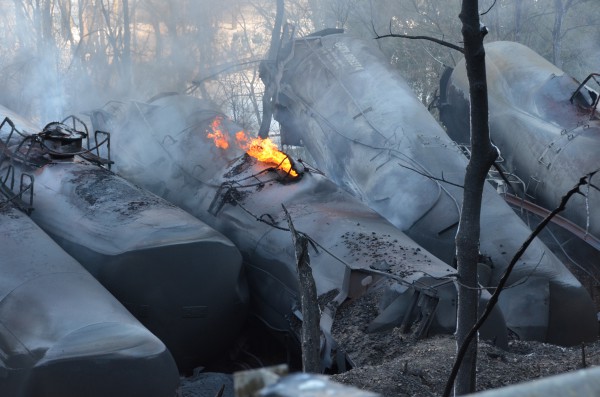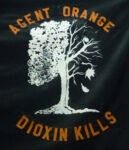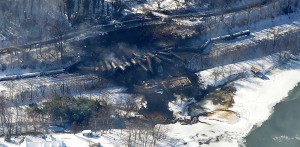A guest blog by Layton Register, who is closely following the clean-up near Mount Carbon, WV, after the derailment and explosions of rail cars carrying Bakken crude oil
This time it was in West Virginia, on February 16: Another oil train crack-up, then blow-up where “at least one home was destroyed, minor injuries were reported and water supplies were disrupted.”
Apparently, CSX was transporting more than three million gallons (70,000 barrels) of oil to Plains All American Pipelines in Yorktown, VA. CSX spokesman Gary Sease was unsure of how much oil was lost. On February 17, he told TV station WSAZ that “at this time, there is no word how much oil spilled into the [Armstrong] creek.”
So, how much oil went up in flames after 19 of the oil train cars exploded? How much oil was excavated from the site where the cars exploded and was taken to a landfill near Charleston, WV? How much oil was pumped from the site and put into frac tanks and shipped off to be processed and “disposed” of? And how much oil spilled into Armstrong Creek and the Kanawha River? At least CSX should be able to say how much lost “product” there was exactly, and then estimates could be made as to how much of the rest went where. We have some answers, but many questions remain.
According to Kelley Gillenwater of the West Virginia Department of Environmental Protection (WVDEP), most of the three million gallons of the crude oil being transported were in “the 80-plus cars that did not derail.” Those cars were moved away from the site, and the oil in them was not counted in the total amount of recovered oil.
According to Sease, each car averages 29,500 gallons (approx. 700 barrels) of oil. The National Transportation Safety Board (NTSB) estimated that 28 (this was first reported as 27) tank cars derailed of the 109 total cars on the train. 19 of the derailed cars caught on fire. UPI reported, “State authorities estimated about a dozen of those [derailed] cars were transporting [Bakken] crude oil from North Dakota, which would equate to approximately 8,000 barrels.”
Gillenwater reports that CSX has recovered 180,984 gallons from the site where the cars derailed. This oil was to be stored in frac tanks located at CSX’s nearby Handley rail yard and eventually delivered to the refinery. Another 112,987 gallons of oil/water mix has been pulled from the containment areas near the derailment site and stored at Handley, 81,542 gallons of which has gone to Petromax in Washington, PA, for “disposal.” Six damaged cars were moved to Handley where the oil was pumped directly into other cars and transported. According to the EPA, “the remaining rail cars that were damaged are staged in a containment area, scheduled to receive cleaning/purging and subsequent staging with security, pending a NTSB investigation.” Assuming all of those cars (working with the first-reported figure of 27 cars derailed) are now empty but were once full, that leaves 438,516 gallons of oil that CSX has lost.
Gillenwater believes most of the oil went up in flames, based on the numerous water tests that have been taken at various locations: “Environmental contractors hired by CSX are taking samples from four sites in the river (between the mouth of the creek and the water plant) and two samples at the water plant once per day. Also, the Montgomery Water Treatment Plant, which is operated by West Virginia American Water, is testing raw and treated water at the plant every six hours. So far, all the results have come back showing no detectable traces of crude oil. Water testing will continue until the site has been deemed remediated.”
Much of the oil that did not burn apparently went into the soil and is being excavated and trucked to a Waste Management landfill near Charleston. An elaborate barge and boom system is in place to contain any oil that goes into the water. A trench has also been dug to capture oil that leaches out of the soil. The oil inside the booms and in the trench has been “vacuumed up” and shipped to Petromax.
So, this leaves a “small amount” that has gone into the water. Gillenwater says the exact amount will probably never be known because “most of the oil burned up in the fire. All evidence, however, points to the fact that very little entered the water. There was only a small amount visible in the creek – and most of that was absorbed by booms or vacuumed out. There has been no visible signs of crude oil in the river other than what was spotted on February 22 when the ice in the creek melted. Also, the most valuable evidence of there being little to no oil in the river is the fact that all of the water tests have come back non-detect.”
How much oil was there exactly on the train? And how much was delivered? The difference will at least provide a baseline of how much was lost, from which it might be determined approximately how much might have gone where.
Gillenwater explained, “CSX also has someone working on a calculation using the amount of oil that was being transported, the amount recovered and data related to the fire to estimate how much oil likely burned. Once that estimate is provided to DEP, it will be part of the public record.”
How much will CSX clean up? It is up to CSX to make a full report of the clean-up, and then WVDEP has to review the report and make sure that the company does everything that it’s supposed to do in the way of remediation. Gillenwater explains that WVDEP “requires the responsible party, which in this case is CSX, to handle the cleanup but to share/report all information to our agency so that we know the work is being conducted according to all environmental regulations and can ensure protection of the environment and public health. We also have inspectors who are on-site often during the cleanup to monitor the progress and who log details of those site visits.”
To help CSX clean up the mess just outside of Mount Carbon, WV, has required the U.S. Coast Guard, the U.S. Department of Transportation, the Environmental Protection Agency, the West Virginia Department of Environmental Protection, the West Virginia Department of Military Affairs and Public Safety, the National Guard and others. There were also numerous private contractors that were hired on, such as RJ Corman, Waste Management, and Goettle Equipment Co.
What will CSX end up paying for the clean-up? This will also be difficult to determine. The company’s 2013 annual report indicates that the company is responsible for the clean-up of over 200 sites (click here, see , pg. 42). There is no detail as to where these sites are located nor how much is being spent where. Whatever amount is paid, it will not be near enough to pay for polluted water and for the damage to the quality of life of folks living in close proximity to these rail-jumping fire bombs.
Furthermore, there are questions as to whether CSX should have been transporting the oil in the first place, due to the oil exceeding allowed limits for vapor pressure.
It seems no one is yet forthcoming with the numbers on exactly how much oil CSX lost, but I’m going to keep trying to figure it out!
Click here to watch some footage Layton Register has taken since this terrifying incident.












This article was very informative, thank you for SHARING your knowledge